Hazardous Effluents and their Impacts on Human Health: Future of Industrial Boom
Muhammad Tayyab Rashid1, Rana Waqar Aslam2*, Waqas Abbas5, Muhammad Burhan Khalid5, Salman Arshad4, Ali Imam Mirza1, Muhammad Hussain Tahir3, Hameed Ullah3, Ali Iqtadar Mirza1
1 Department of Geography, Government College University, Lahore.
2 State Key Laboratory of Information Engineering in Surveying, Mapping and Remote Sensing
(LIESMARS), Wuhan University, Wuhan 430079, China.
3 College of Earth and Science Department, University of the Punjab, Lahore, Pakistan.
4 Department of Space Science, University of Punjab, Lahore.
5Punjab University College of Information & Technology, University of the Punjab, Lahore.
*Corresponding Author Rana Waqar Aslam Email: ranawaqaraslam@whu.edu.cn.
Citation | Rashid.M.T, Aslam.R.W, Asad.M, Khalid.M.B, Arshad.S, Mirza.A.I, Tahir.M.H, Ullah.H “Hazardous Effluents and their Impacts on Human Health: Future of Industrial Boom”. International Journal of Innovations in Science & Technology, Vol 02 Issue 04: pp 150-161, 2020.
Received | Oct 16, 2020; Revised | Oct 15, 2020 Accepted | Oct 18, 2020; Published |
Nov 21, 2020.
Abstract
Industries, being commercial productive units perform as manufacturing agents to produce large quantity of goods to cater the needs of increasing population. Manufacturing units use raw material and goods to deliver the final product. The findings of this research are consistent and reliable. The study area mainly consists of three types of industries including iron and steel, chemical and fertilizer and plastic industry. The hazardous waste generated by industries in Pakistan was computed as 1 lac tons per day and more than 10 thousand
tons/day in Lahore. These wastes played a vital role in the degradation of environment. In addition, various harmful gases such as fluoride, carbon monoxide and dust were released by these industries which mixed with fog and caused smog that resulted in respiratory diseases and the Lahore remained in smog for last 3 years. The air quality declined to alarming level because of the dust produced by these industries. Air pollution leads to skin problems, and respiratory diseases among residents living in outskirts of these industries. In this research it is estimated that industrial emission is more dangerous than any other emissions. From the
year 2008 to 2019 the harmful emissions were categorized as 43% by transport sector, 25% by industries, 20% by agricultural sector and 22% by power sector. Proper planning and management is required to secure the safety of environment from the adverse effects of industries.
Keywords: Industries; GIS; hazards; human health and urbanization.
INTRODUCTION
Industries being commercial productive units perform as manufacturing agents to produce large quantity of goods causing improvements in industrial activities. Manufacturing units use raw material and goods to deliver the final product. The first industrial revolution was started initially in Europe, North America and Britain then followed by other countries including Belgium, Switzerland, Germany, and France. The Second Industrial Revolution Started after the refinement of steam engine (New Invention of Internal Combustion
engine). The industries got easy access to markets by the construction of railways and canals in the east Asia and other parts of the world which become industrialized by the end of 20th century [1].
After the independence in 1947, Pakistan got only 4% of the entire industrial sector established in subcontinent. Government took initiative to establish new industries especially relating to manufacturing and service sectors. Manufacturing industry is a secondary industry according to the industrial classification. It is a type of industry that manufactures products from raw material. In Pakistan, since 1947, major stress is laid on the agriculture-based manufacturing industries including the textile industry. Currently, a large number of
manufacturing industries are running in Pakistan including textile mills, Glass Mills, Rice Mills, Sugar Mills, Paper and board Mills and steel mills etc.
Besides their importance industries are a major cause of pollution. Industrial waste is hazardous for the environment. Industries are responsible for air and water pollution which produce maximum toxic gases in sunshine hours [2]. Water and air effluents such as chemicals and biological matters are released by industries. Commercial waste contains arsenic, plumage, mercury, cadmium, zinc chemicals and heavy metals which can be harmful for human health and ecosystems. These pollutants are highly involved in blockage of urban heat and the terrestrial radiations which cause to make the urban areas as heat islands [3].
Polluted water has significant effects on land production when used for irrigation. In surface and groundwater environment, the high concentration of chemical compounds and metals causes extreme damage to river ecology. Surveys have been accomplished in a number of these cities that displayed pollution of water, soil, and air [4].
Like human activities, industrialization has profound environmental impacts such as pollution and degradation. It has been a major cause of air pollution, noise, soil, impure water quality and the destruction of natural environment in general. Industrialization is fundamentally the transition between various human communities (including urbanization,and political and technological progress) and their economies (manufacturing) from an agrarian to an industrial society [5].
Industrialization not only requires technological innovations, but it also plays a vital role in society's economic and social transition. Industries also cause tremendous pollution; indeed, industries are the key factors behind ozone depletion. Industrialization has created many environmental issues for the developing world, including water, air pollution and soil depletion. The enhanced cycle of various human activities like agriculture, urbanization, and industrialization have put huge pressure on available reservoirs of fresh water [6]. Nearly
75% of the world's population is devoid of pure water for drinking and water pollution is also a problem for agriculture [7].
Rapid urbanization and industrialization were faced by various developed countries in 1800 [8]. The industrial revolution gave benefits to poor people in order to strengthen their earnings. The economy of every country was based upon economic development and industrial revolution, and the countries were ranked on basis of their economic development e.g., Britain, North America and Japan etc. In India, the industries like cotton, jute, silk, and woolen textiles, sugar cane, and vegetable oil are very significant. These industries provide
employment to 35 million people, contributes 4% to the GDP, and 14% of the total industrial production of India. industrialization is significant cause of economic development as well as pollution increase [9]. Air pollution is caused by poisonous gases like carbon mono-oxide, and Sulphur-dioxide. The untreated hazardous industrial effluents which are dumped into water bodies cause water pollution. Groundwater contaminated with transition metals pose a devasting effect to public health [10]. Direct or indirect disposal of oil, fuel and other hazardous wastes from waste disposal sites are major cause of water and soil contamination.
Municipal Solid Waste (MSW) disposal includes all sorts of air, land and water contamination. Decomposition of organic waste and other contaminants release Green House gases. The health and safety concerns due to MSW include the prevalent diseases such as cholera, diarrhea and dengue fever. Pollution of water and soil is a key cause of many health problems. The US Public Health Service recognized 22 human diseases caused by
MSW. However, solid waste is described on the basis of their sources, waste type and the rate of generation or composition and is categorized as industrial, institutional, medical and municipal waste. Solid waste has different characteristics that are corrosive (waste include acids and bases), ignitability (create fires), reactive (unstable in nature, cause explosions) and toxic (harmful) in nature [11].
The waste disposal is a weak system in Lahore city. UN-Habitat environmental management technique is a managed facility to dispose of or treat the waste. As a component of Lahore-2021 master plan, a proposal was made for three new landfill sites, but only one of these is currently in operational mode, Mehmood Booti. Two more LWMC sites, named as Saagian dumpsite and Bagrian/Tiba dumpsite, are also not officially used for
the disposal of waste.
Various models are available to compute the effect of solid waste on eco system. The CML method is developed by the Environmental Science Institute at Leiden University which means that the effect is measured at the midpoint of the region. For the estimation of health effects, we use the USES-LCA multimedia model based on USES 2.0 [12,13,14]. Preconsultants developed the Eco-Indicator 99 method which takes a damage-oriented approach in order to estimate damage to human health [15]. In 2009, the model used for
CML and the Eco-Indicator 99 approach in terms of model settings were harmonized.
In order to compare and qualify the environmental effects, the EPS method is established. In this system, human health is divided into various sub-categories, including life expectancy, serious morbidity, serious nuisance, nuisance to find the factor [16]. The UNEP and SETAC models are of scientific consensus used for human health assessment. The EDIP method was developed under the Danish industrial product environment design scheme and has an oriental midpoint approach [17]. The MRC method is used to find
inorganic gases which are inhaled by humans such as benzene, toluene, dichloromethane. The MRD is the method used to find the substances including heavy metals like cadmium, chromium, mercury and lead used in food ingestion.
Industry is a two-sided coin having both negative as well as a positive side. Besides the fact of being job provider, the industries are main cause of environmental pollution. So, for the better understanding of advantages and disadvantages of industries are required to examine. One has to know about its location, type of industry, types of products and type of hazardous wastes which a particular industry produce. Moreover, a systematic and helpful study is conducted in this research to figure out the industrial hazardous effluents and their impacts on human health. This study aim at investigating the impacts of industrial boom on climatic conditions of Lahore and its impact on human health by examining the hazardous affluent of industries in local environment. It also aims to provide a better picture of urbanization in Lahore and to share and review appropriate background information, views about urbanization and its frontiers, point out the major problems and suggest the possible and more relevant solutions.
Material and Methods.
Investigation site.
Lahore is the capital of Punjab Province located at 31.582045 N, 74.329376 E. It is considered to be the second largely populated city after Karachi. It is situated at the upper Indus plain of the Ravi River. Lahore district is divided into nine main towns among one zone is designated as military zone. There are total 12 million people living in the urban area of the city and about 6 million people living in the main city area. Figure 1 is showing Lahore’s different Union Cornicle and their surrounding districts. People from surrounding rush towards Lahore on daily basis for their livelihood and education. Interview Short interviews were taken from the officials located in PHD (Public Health Department) Lahore, WASA (Water and Sanitation Agency) Lahore and EPA (Environmental Protection Agency) Lahore in order to get an interpretation of the selected area. Interviews of locals were conducted to examine the impact of industries on the health of residents.
Field Observations
Field observations are basic start to conduct a research. It is a non- experimental technique to get to know about the ongoing problem which is under observation. which may be inaccurate data and can be considered false. As far as concerned to our personal observations, Lahore has been changed a lot since last 2 decades. The rapid increase in urbanization and development of more industries is the major reason of change in the city in both positive and negative aspects. Lahore has always been a hub of art, culture, industries, education and commerce. Due to these opportunities, people from all over the country migrate towards the city. This change is disturbing the sustainability of the city and if it would not be controlled, it can result in the major of the city .
Figure 1. Location map of Lahore district GPS Survey GPS device was used to collect locations of industries to compute various algorithms e.g., proximity buffer analysis. Statistical analyses SPSS was used to determine a variety of algorithms including correlation and variance etc. Pie charts were prepared and used to inform of pie charts for build-up area, vegetation, water body and barren land to show the distinct portion of these areas. Location maps and risk assessment maps were made which include industrial and clinical location maps for risk assessment of industries. The risk assessment maps were prepared for buffer analysis to understand the vulnerability of the residential areas.
Result and discussion.
Identification of Industries Figure 2,3 show that the study area consists of three types of industries including Iron & Steel, Chemical & Fertilizer and Plastic Industry. It was essential to examine the trend of expansion of these industries which was in the north-west side of Lahore and expanding continuously in the same direction.

Figure 2.Map of Industries in Lahore

Figure 3. Map of Industries in Daroghwala In Lahore city, the estimated total amount of waste generation was 5300 tons per day. The waste includes different types like Combustible waste, Non-Combustible waste, Plastic waste, Biodegradable waste and hazardous waste as shown in Figure 4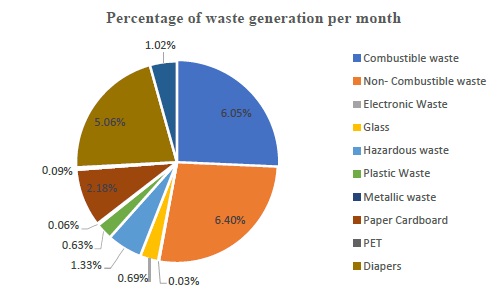
Figure 4. Percentage of Waste Generation
There are three types of industries which are identified in this research which include plastic industry, iron or steel industries and chemical or fertilizer industries. These industries use different Raw materials to produce end products. These industries generate hazardous waste products which are harmful for both the nature and human health. Along with the production of commercial, social and economical products, industries are also a source of pollutants which are released as by products. There are some industrial products with their
hazardous waste as given in table 1.
Table 1. Industrial products and their hazardous waste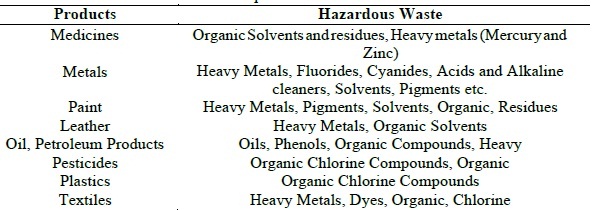
Table 1 show that the industries has both beneficial and nonbeneficial effects towards environment.
Chemical industries produce medicines, paints, and different pesticides. These products are necessary for the protection of health, metals, and farms respectively. But the improper disposal of chemical wastes into rivers and canals are causing water pollution which in turn is threat to aquatic life.
Plastic polymers
The Plastic Toxicity is very dangerous for our health. The Polymers of plastic have their own impacts on human health. Polymers, their compounds (monomers and additives) and degradation products were categorized into five qualitative groups of hazards for human life and the environment in evaluating the risk assessment of plastics (very low to very high hazard).
Characteristics of hazardous waste
EPA (Environmental Protection Agency) defined the characteristics of hazardous waste which includes Ignitibility, Corrosively, Reactivity, or Toxicity.
Ignitable Wastes
1. Liquids waste (having a flash point below 140F)
• Alcohol solutions (which contain more than 24% alcohol by volume)
• High-performance liquid chromatography (HPLC) liquids (which often contain
highly flammable solvents such as Acetonitrile)
• Glass-cleaning solvent rinses
2. Combustible solid waste.
• metal powders
• activated charcoal
3. Ignitable compressed gases
• Gas cylinders for lab burners (butane, propane, etc.)
4. Oxidizers
• nitrate compounds
• peroxide compound
• perchlorate compounds
Corrosive Wastes
Any liquid having a pH less than 2 or higher than 12.5
• Inorganic acids (hydrochloric, phosphoric, nitric, sulfuric, etc.)
• Organic acids (formic, acetic, lactic, etc.)
• Alkaline compounds (hydroxides, amines, etc.)
Reactive Wastes
1. Compounds which are normally unstable and readily undergo violent change without
detonating.
• diethyl zinc
• organometallic gases
2. Compounds which will violently react with water
• anhydrous metal salts
• alkali metals
• metal powders, shavings, or turnings
3. Compounds which form potentially explosive mixtures with water
• calcium carbide
• metal hydrides
• chloro-silanes
Table 2. EPA Toxicity Characteristic List
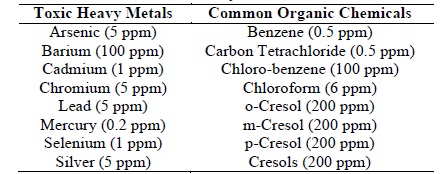
Different kinds of harmful gases such as fluorides, carbon monoxide and dust are released into air from grinders and other iron and steel production industries are pulverized during the processing of phosphate rock. The blend/reactor creates gases containing silicon tetra fluoride and hydrogen fluoride. There are two major air pollutants in a sulphuric acid factory, Sulphur dioxide and acid mist. When roasting pyrite ore, iron, steel grinder is also an air pollution particulate with heavy metals such as cadmium, mercury and plum. Phosphoric acid plants produce hydrofluoric acid-containing fumes and fluoride silicone tetra Glaser. The air emissions also cause smog which is a mixture of fog and air emissions caused by combustion in industries and burning of crops. This smog causes respiratory diseases also cause irritation to eyes and skin. Lahore has been affected by this smog from last 3 years. The air quality is getting declined day by day because of industrial and transport emissions and burning of crops.
Table 3. Different sectors and their air emission percentages
Industrial Impacts
The industrial impact is determined through the industrial waste processing but due to Covid_19 the sampling method is not done. However, the impact assessment is done by using the secondary datasets. The secondary datasets were analyzed to determine the diseases caused by the industrial waste contamination in underground water resources, in fertile soil and in air. The disease analysis was done by the gathering the hospitals data. The hospitals data express the common diseases outbreaks in these industrial zones and their
average increase in percentage as given in Table 4.
Table 4. Impacts on Hum an Health
Table 4 shows the percentage of different diseases among people living in industrial areas as reported by hospitals situated in outskirts of industrial zone. The diseases which have been mentioned in Table 4 are all because of industrial waste which was mismanaged.
Risk Assessment of Industrial Surrounding Areas
Buffers were created within 500 meter of each industry in its surrounding as shown in Figure 5 and it was observed that all the residential area within this domain is at high risk. Because these settlements were most vulnerable to the industrial waste created or produced by these industries.
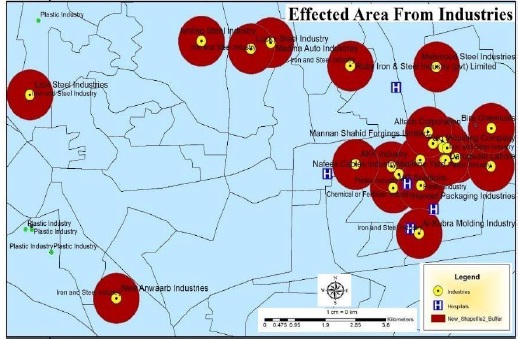
Figure 5. Map of effected areas by industries
Figure 6 is showing that the medical institute which helped the people to fight against different diseases caused by industrial effluents.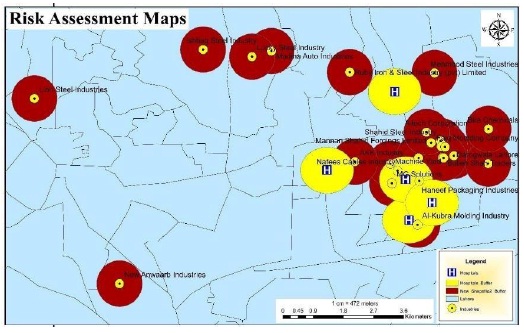
Figure 6. Risk assessment Map
Figure 6 is showing that the location of medical institute to resolve the health issues of human lives under that risk zones. The risk from industries is increasing day by day because of population growth as well as increase in pollution.
Acknowledgement. The author would like to acknowledge Dr. Ali Iqtadar Mirza for his guidance and supervision.
Author’s Contribution. All authors have contributed equally.
Conflict of interest. The authors declare no conflict of interest in publishing this manuscript in IJIST.
REFERENCES
1. Aslam, Rana & Amjad, Dania &Kausar, Sumaira& Sarwar, Faiza. (2019). Land cover change analysis and impacts of deforestation on the climate of District Mansehra, Pakistan. Journal of Biodiversity and Environmental Sciences. 14 (6). 103-113. 10.6084/m9.figshare.13352873.v1.
2. Hassan.S.S, Mukhtar.M, Haq.U.H, Aamir.A, Rafique.M.H, Kamran.A, Shah.G, Ali.S and Mahmood.S.A “Additions of Tropospheric Ozone (O3) in Regional Climates (A case study: Saudi Arabia)”. International Journal of Innovations in Science and Technology, Vol 01 Issue 01: pp 33-46, 2019.
3. Gillani.S.A, Rehman.S, Ahmad.H.H, Rehman.A, Ali.S, Ahmad.A, Junaid.U, and Ateeq.Z.M Appraisal of Urban Heat Island over Gujranwala and its Environmental Impact Assessment using Satellite Imagery (1995-2016).
4. Aslam, Rana & Saeed, Urooj & Mehmood, Hammad & Ullah, Hameed & Younas, Imtiyaz. (2017). Impure Water, a Future Disaster: A Case Study of Lahore Ground Water Quality with GIS Techniques.
5. O'Sullivan, A. and S.M. Sheffrin, 2003. Economics: Principles in Action. 2nd Edn., Upper Saddle River, Pearson Prentice Hall, New Jersey, USA., ISBN-13: 9780130630858, Pages: 592.
6. Imran.R.M, Rehman.A, Khan.M.M, Jamil.M.R, Abbas.U, Mahmood. R.S, and Mahmood.S.A, Ehsan. U.H. Delineation of drainage network and estimation of total discharge using Digital elevation Model (DEM).
7. B. Steen, A systematic approach to environmental priority strategies in product development (EPS), Version 2000 – Models and Data of the default system, Chalmers University of Technology, Centre for environmental assessment of products and material systems (CPM) Report 1999 (5), Göteborg, 1999.
8. Saifullah.M, Zafar.M, Sohail.A, Mehmood.F, Musharaf.M, Khan.J, Ashfaq.A and Mahmood.S.A. “Appraisal of Urban Sprawl in Mega Cities of Punjab Pakistan in context of Socio-Political Issues using RS/GIS”. International
9. A.J. Huijbregts, J. Struijs, M. Goedkoop, R. Heijungs, A. Jan Hendriks, D. van de Meent, Human population intake fractions and environmental fate factors of toxic pollutants in life cycle impact assessment, Chemosphere 61 (2005) 1495–1504.
10. Batool.S.S, Abbas.A, Hussain.I, Wahab, Shafique.A, A, Zaheer.M. “Bacteriological and Physicochemical Analysis of Groundwater of Kasur”. International Journal of Innovations in Science & Technology, Vol 01 Issue 04: pp 151-167, 2019.
11. M. Hauschild, H. Wenzel, Environmental Assessment of Products. Vol. 2: Scientific Background, Chapman and Hall, London, 1998.
12. A.J. Huijbregts, J.B. Guinée, L. Reijnders, Priority assessment of toxic substances in life cycle assessment. Part III: Export of potential impacts over time and space, Chemosphere 44 (2001) 59–65.
13. A.J. Huijbregts, U. Thissen, J.B. Guinée, T. Jager, D. Kalf, D. van de Meent, A.M.J. Ragas, A. Wegener Sleeswijk, L. Reijnders, Priority assessment of toxic substances in life cycle assessment. Part I: Calculation of toxicity potentials for 181 substances with the nested multi-media fate, exposure and effects model ASUS-LCA, Chemosphere 41 (2000) 541–573.
14. oeller, D. W. (2005). Environmental Health (3rd ed.). Cambridge, MA:Harvard University Press
15. B. ehera.B and Reddy.VRatna (2002), Environment and Accountability: Impact of industrial Pollution on Rural Communities. Economic and Political Weekly, Vol. 37, No. 3, pp. 257-265
16. Tahir, Muhammad & Ahmad, Sajid & Aslam, Rana & Ahmad, Israr & Ullah, Hameed & Aziz, Aqsa & Zubair, Muhammad Hamza & Mirza, Ali & Hassan Raza, Dr-Syed. (2020). CRITICAL STUDY OF GROUNDWATER QUALITY OF METROPOLITAN LAHORE USING GEO-SPATIAL TECHNIQUES. 2. 89-105. 10.6084/m9.figshare.13352717.v1.
17. Toxicological Profile for Benzene, Agency of toxic substances and Disease registry (ATSDR), Atlanta, 2007).




















